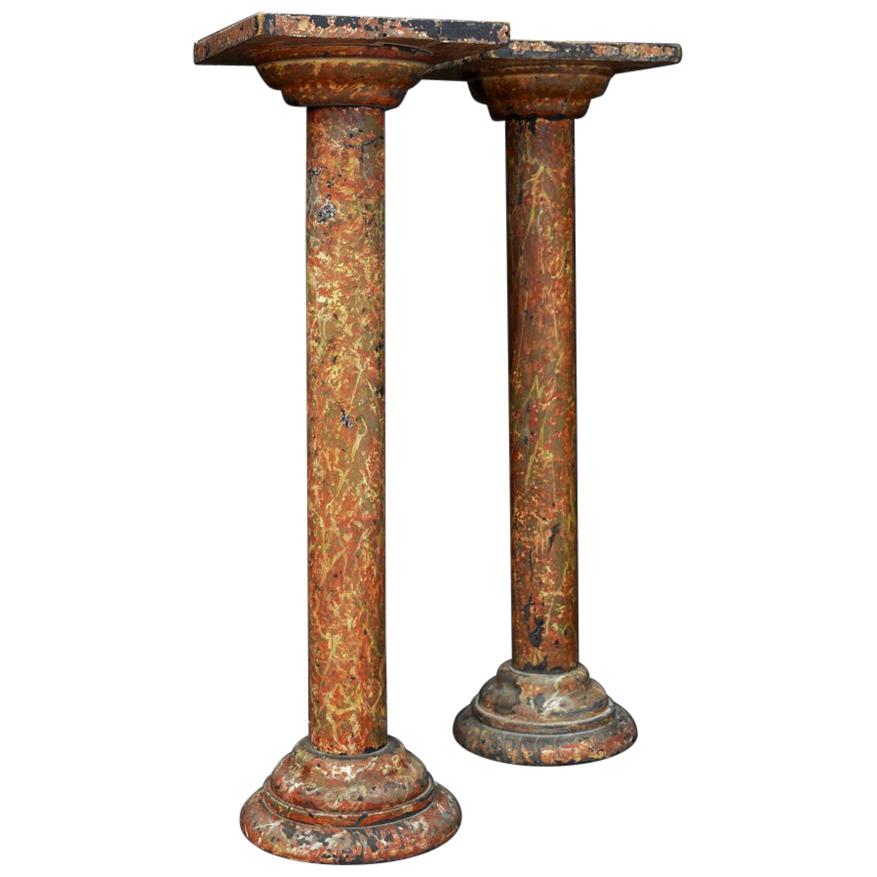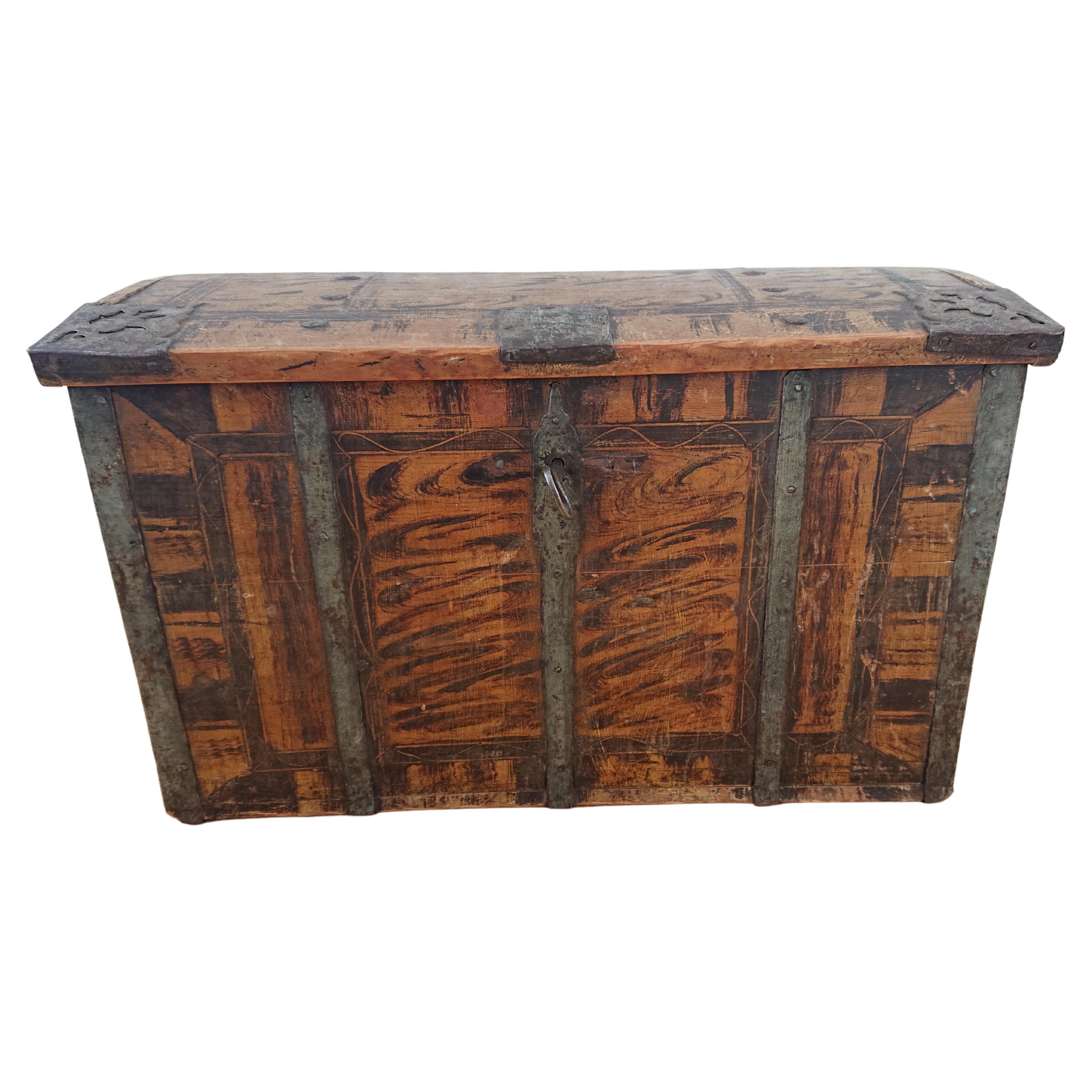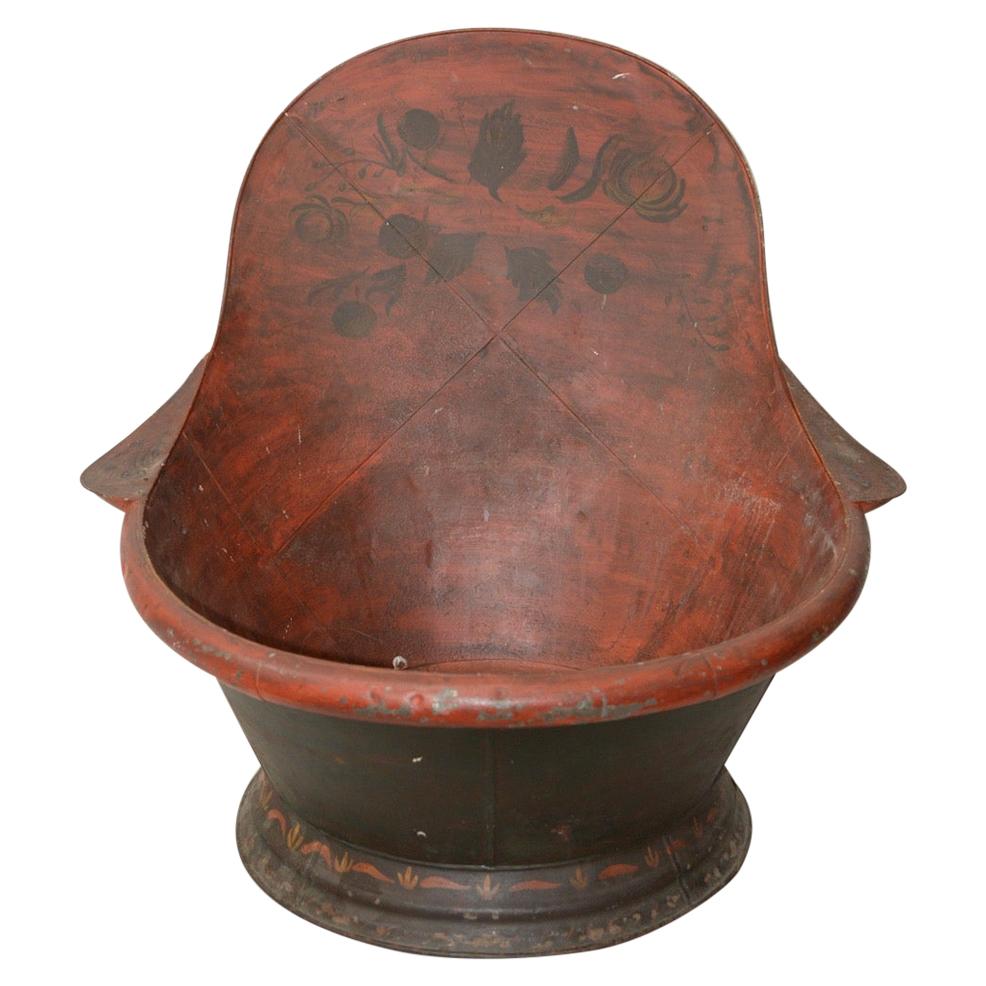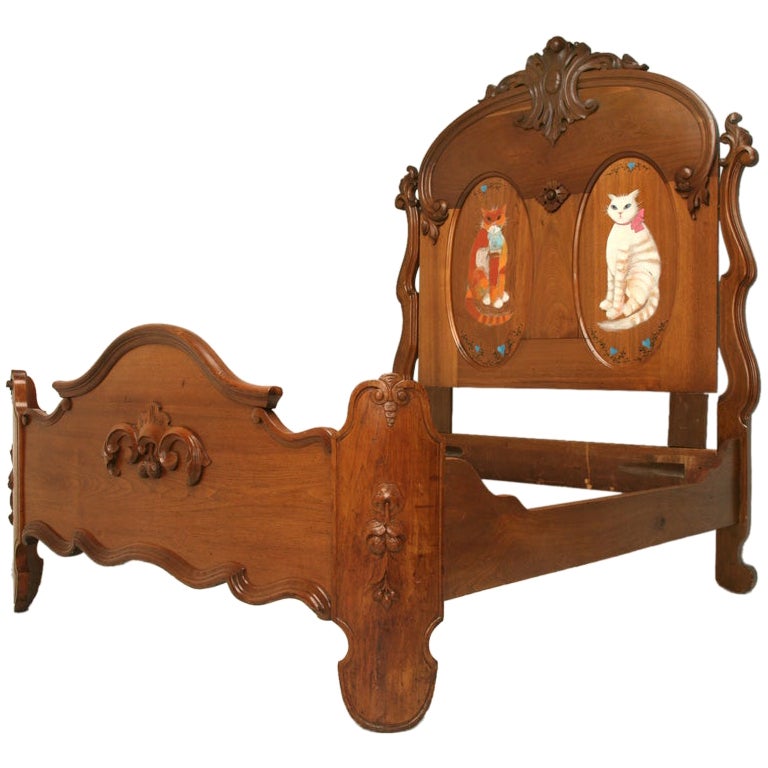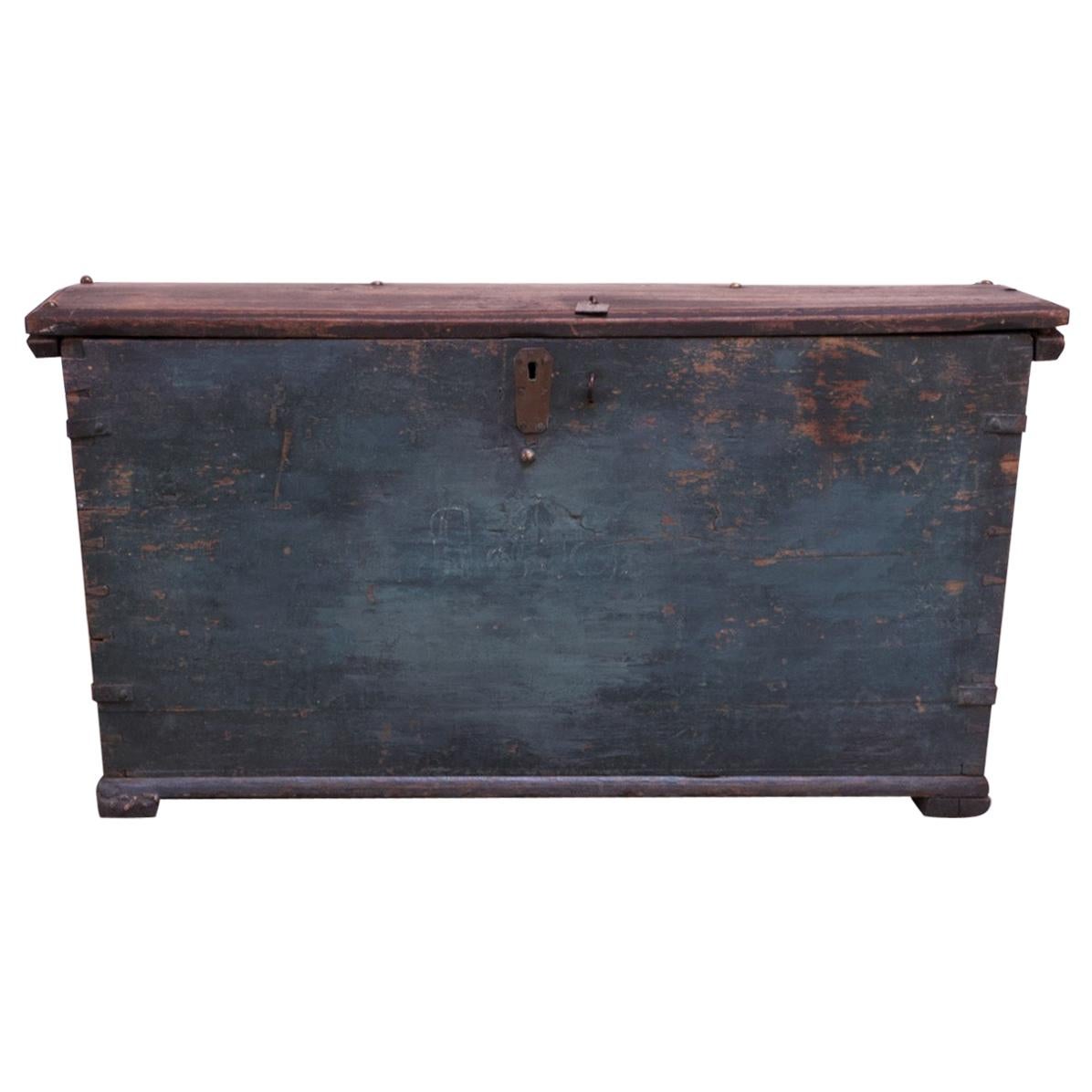Items Similar to Antique Alaska Gold Rush Bath Tub / Trunk / Table Circa 1880s
Want more images or videos?
Request additional images or videos from the seller
1 of 10
Antique Alaska Gold Rush Bath Tub / Trunk / Table Circa 1880s
About the Item
Our unique metal wash basin with lid dating from the late 19th century was hand-painted with wood like finish and lid celebrating the owner's adventure participating in the Alaska gold rush of 1881 at Silver Bow Basin. The top is finely painted, depicting various artifacts from the adventure, such as axe, pan, scale, pistol, playing cards, an American eagle carrying shield with flag, and features a poem that reads in part, "Found my gold in my pan, going home a happy man!".
An extraordinary example of antique Americana.
Would make a charming low, coffee or cocktail table, used as-is, or covered with glass top.
- Dimensions:Height: 13 in (33.02 cm)Width: 33.5 in (85.09 cm)Depth: 25 in (63.5 cm)Seat Height: 13 in (33.02 cm)
- Materials and Techniques:
- Place of Origin:
- Period:
- Date of Manufacture:c1880s
- Condition:Wear consistent with age and use. Minor losses. Scuffs, scratches, dents, rubbing wear. Missing lock and key.
- Seller Location:New York, US
- Reference Number:1stDibs: LU6079238342092
About the Seller
No Reviews Yet
Vetted Seller
These experienced sellers undergo a comprehensive evaluation by our team of in-house experts.
Established in 1990
1stDibs seller since 2021
Typical response time: 1 to 2 days
- ShippingRetrieving quote...Ships From: New York, US
- Return PolicyA return for this item may be initiated within 2 days of delivery.
More From This SellerView All
- Boucheron Parcel Gilt Silver Vase and Oil Lamp circa 1880By Fréderic BoucheronLocated in New York, USOur important parcel-gilt and patinated silver and glass-mounted vase and matching oil lamp were designed by Paul Legrand (1840-1910) and crafted by the silversmith, Charles Glachant, for Boucheron of Paris, circa 1878-1880. 21 in tall and 16.5 in wide (53.4 by 41.9 cm). 28.56 lbs, 457 oz, 14,210 g. Provenance: presented to or purchased by Jean-Baptiste Pezon (1827-1897); acquired by a European private collector, perhaps on the death of Jean-Baptiste Pezon in 1897, by descent; acquired by YM Antiques, 2017. This double walled vase has an amphora form, with body and foot with silver, gilt and patinated and stylized flowers, anthemions and sprays of cherries against an etched and matted ground pierced to reveal a gilt inner wall. The upper body is detachable via a slip-lock, and mounted on both sides with arched panels formed of hexagonal beveled glass tiles. One glass panel applied with bacchic infants taunting a rearing goat and the other side with infants feeding grapes to a lioness under a looming bust of a satyr. The patinated and gilt upswung loop bifurcated handles are mounted with fully modeled figures of Pan bearing a syrinx and thyrsus and a draped maenad playing two flutes, both above roaring lion heads, the rim inset with a slip-lock detachable gilt bowl etched with masks of various representations of Bacchus spaced by ribbons and trophies and with scrolling fruiting vines. The base of interior with detachable base metal drip pan to accommodate the removable oil lamp designed to illuminate the glass tiles from within. The lamp is raised on four hoof feet, the upturned ends cast underneath with masks and with detachable cover mounted with two infant satyrs and flanked by gilt loop handles. The bacchic themed design featuring cartouches depicting infants taunting a goat and lion, plus prominent lion masks at the handles, certainly appealed to Boucheron's customer, Jean-Baptiste Pezon (1827-1897), who is believed to have commissioned the piece. Pezon was the celebrated lion tamer and headliner of the Grande Menagerie whose profession brought him great fame and fortune in Paris. Born a shepherd boy in Lozere, he is said to have left his home at the age of seventeen in the company of a wolf he had captured and trained years earlier. He headed to Paris and by the age of twenty-one purchased his first lion who he named Brutus. The animal is said to have inspired the Lion of Belfort, the monumental red standstone sculpture by Frederic Bartholdi erected in Belfort in 1880. Toulouse-Lautrec was among his admirers and friends, visiting Pezon's Great Lozerian Menagerie to sketch animals. A large bronze sculpture of Pezon atop a female lion adorns the Pezon family tomb in the Pere Lachaise Cemetery in Paris, as seen in our image here. The vase and detachable bowl are marked on the underside with the silversmith's mark of Charles Glachant. The underside and upper rim of the lower body is engraved "Fic Boucheron Paris". The lamp is marked on underside and flange of cover for Glachant. Boucheron archives indicate the vase was inspired by the amphora vases created by the Greek potter, Nikosthenes, 550-510 BC. The Nikosthenic amphora vases are a form of Attic vase recognized for their angular amphora form with broad flat handles. Potted of bright orange-red clay, they were decorated with plant and animal motifs within distinct friezes, with the most significant defining feature being the black figure painting, often highlighted with white accents. In this vase Legrand re-imagines the striking contrast of the black figures against a warm ground through the use of patina and gilding. His inventive use of piercing and double-wall construction create additional levels of texture and depth throughout the body. The same combination of ornamentation was employed in a ewer designed by Legrand in 1880 in the Islamic taste. (See lot 77 of Christie's sale in New York on October 22, 2009.) Edmé Bouchardon (1698-1762), royal sculptor to Louis XV, may have provided Legrand with inspiration for the vase's iconography. The panel featuring bacchic infants taunting a rearing goat is very similar to a bas relief representation of Winter designed by Bouchardon for the Fontaine des Quarte-Saisons on rue de Grenelle, Paris. Bouchardon debuted his plaster model for the bas relief in 1741, and the fountain was completed in 1745. The Boucheron firm, founded by the celebrated jeweler, Frédéric Boucheron...Category
Antique 1880s French Greek Revival Vases
MaterialsSilver
- Antique Russian Neoclassical Gold and Agate Snuff Box Circa 1820sLocated in New York, USOur wonderful snuff box features a finely carved agate relief depicting Bacchus and Cupid, scrolling foliate motifs and roundels against a matte ground, and cover with blue enamel bo...Category
Early 20th Century Russian Neoclassical Revival Snuff Boxes and Tobacco ...
MaterialsGold
- Matched Pair Antique Austrian Silver-Gilt Ewers Circa 1780sLocated in New York, USOur pair of elegant silver-gilt ewers are attributed to the Austrian maker, Johann Georg Hann of Vienna, circa 1780-1800. Heights: 17 7/8 and 22 1/2 in; 45 a...Category
Antique Late 18th Century Austrian Neoclassical Pitchers
MaterialsSilver
- Antique Art Deco Period Snake Form Table Lamp with Amber Glass Beaded ShadeLocated in New York, USOur Art Deco period patinated bronze table lamp in the manner of Edgar Brandt is fashioned in the form of a coiled snake with hammered metal shade hanging from its mouth, with shade ...Category
Early 20th Century Austrian Table Lamps
MaterialsBronze
- Italian Neoclassical Marble Shaving Mirror, Circa 1810Located in New York, USOur shaving mirror in the neoclassical style was crafted in Italy from carved marble, circa 1810. The only all-marble standing mirror of its kind we have seen come to market in the p...Category
Antique Early 19th Century Italian More Mirrors
MaterialsMarble
- Napoleonic Silverplated Tray by Christofle circa 1850By ChristofleLocated in New York, USOur Christofle silverplated tray features fine engraved designs including the French coat-of-arms, and Napoleonic cipher and imperial bees. Reverse has the maker's mark in oval carto...Category
Antique Mid-19th Century French Empire Sheffield and Silverplate
MaterialsSilver Plate
You May Also Like
- Pair of Faux Marble Columns, circa 1880Located in London, GBPair of faux marble columns, circa 1880. This lot is an exceptionally rare original pair of faux marble effect columns dated 1880. These...Category
Antique 1880s Italian Folk Art Pedestals
MaterialsWood
- 18th Century Swedish Folk Art antique rustic Trunk /ChestLocated in Boden, SE18th Century Swedish antique rustique Chest from Boden Norrbotten, Northern Sweden. The chest has untouched original paint. The trunk was dated 1799 to celebrate a birthday ,and the ...Category
Antique Late 18th Century Swedish Folk Art Painted Furniture
MaterialsPine
- French 19th Century Toleware Bath / PlanterLocated in San Francisco, CAFrench 19th century Toleware bath / planter Fantastic old tin tub that could also be a nice planter on your patio. Painted with Americana style Arts & Cr...Category
Antique Late 19th Century French High Victorian Painted Furniture
MaterialsMetal
- Swiss Alp Painted Pine TrunkLocated in grand Lancy, CHSwiss alp painted pine trunk ,from Rougemont village , the inside of the trunk was painted later and a part of the foot are missing, see photoCategory
Antique Early 19th Century Swiss Painted Furniture
MaterialsWood
- American Victorian Folk Art Bed with Hand-Painted Cats, circa 1880 Solid WalnutLocated in Chicago, ILThe Kitties are here, looking for a young lady to watch over each night. Decorated with walnuts, this amazing Antique Victorian Bed was made usin...Category
Antique 19th Century American Victorian Beds and Bed Frames
MaterialsWalnut, Elm, Oak
- Early Americana Painted Wood Monogrammed TrunkLocated in Brooklyn, NYPrimitive trunk / chest composed of a hinged wood plank top and painted wooden frame with brass and steel embellishments (brass nailheads with hand-hammered steel handles / hinges / ...Category
Antique 18th Century American Primitive Painted Furniture
MaterialsBrass, Steel
